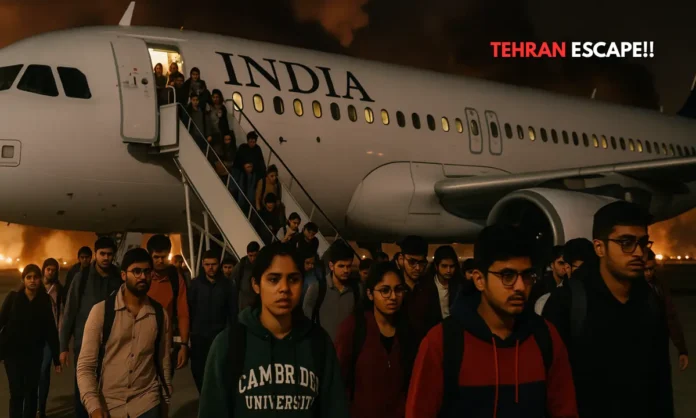SUMMARY
- A special evacuation mission has airlifted 110 Indian students from Iran to Armenia, with a flight to Delhi scheduled next.
- The students, trapped amid Iran-Israel airstrikes, reported witnessing drone-filled skies, blackouts, and direct missile impacts.
- India’s diplomatic helplines have been activated, but calls are growing louder for a wider Operation Ganga-style mission.
Drones, Missiles, and Blackouts: Indian Youths Trapped in Tehran’s Crisis Zone
As Israeli airstrikes continue to rain down on Iranian cities and nuclear facilities, India has launched its first emergency evacuation of nationals from the region—airlifting 110 Indian students from Tehran to Armenia. The students, most of whom were enrolled in medical and technical programs, spent several days under siege in Tehran’s dormitories as fighter jets, drones, and missile strikes created a nightmarish warzone. Eyewitness accounts from the students described sleepless nights, black smoke rising outside dorm windows, and panic-filled hours under blackout orders.
The situation escalated after Israel launched “Operation Rising Lion” targeting Iran’s nuclear infrastructure. Iran retaliated with massive drone and missile attacks—turning cities like Tehran and Natanz into battlefields. Despite efforts by university officials to maintain calm, students repeatedly appealed to the Indian government for immediate evacuation.
This evacuation marks India’s most high-risk extraction mission since its Ukraine effort in 2022, triggering comparisons to “Operation Ganga.” However, with thousands of Indian citizens still scattered across various Iranian provinces, including students, pilgrims, and businesspeople, pressure is mounting on New Delhi to scale up operations urgently.
JUST IN: MEA on evacuating Indians from Iran
— Padmaja Joshi (@PadmajaJoshi) June 17, 2025
-Indian students moved out of Tehran by the Indian embassy.
-separately, those who have the means and transport available are advised to leave independently
-movement of some Indians also facilitated through Armenia border pic.twitter.com/PcKYqraZNp
India’s Diplomatic Machine Under Fire: Evacuation Helplines vs Ground Reality
- Indian Embassy in Tehran issued new advisories urging all nationals to register via a Telegram link.
- Round-the-clock helplines have been activated in both Iran and Israel.
- India’s Ministry of External Affairs (MEA) confirmed further evacuation efforts are under planning.
The Indian government, while acknowledging the gravity of the crisis, has so far limited its public statements to confirming the safe transit of the first batch of students. Emergency contacts have been shared through official X (formerly Twitter) handles, with MEA spokespersons reiterating the government’s commitment to citizen safety. Yet, those still in Iran remain anxious.
“The evacuation of 110 students is a great first step, but what about the hundreds still left in Qom, Mashhad, and Isfahan?” asked a concerned parent whose daughter remains stranded in central Iran. In Israel, too, the Indian embassy has activated emergency helplines as fears of a wider regional war grow.
India is walking a diplomatic tightrope—maintaining relations with both Israel and Iran while protecting its citizens abroad. The latest move to evacuate students without a broader “airlift” plan has drawn criticism from sections of the opposition, who accuse the government of slow response.
Operation Rising Lion vs Operation True Promise: Students Caught in Crossfire
- Israel claims its operation is a preemptive strike to stop Iran from acquiring nuclear weapons.
- Iran has responded with a counter-offensive called “Operation True Promise 3,” striking Israeli fuel facilities and energy centers.
- More than 200 deaths reported in Iran, with over 20 casualties in Israel.
The students’ escape from Tehran came amid the deadliest week of combat between the two nations. Iran’s Islamic Revolutionary Guard Corps (IRGC) intensified strikes against Israeli targets, including airbase fuel depots. Meanwhile, Israeli missiles struck Tehran’s broadcast headquarters—live on air—rattling public confidence.
Iran’s Foreign Minister Abbas Araghchi warned that continued aggression would derail all ongoing diplomatic negotiations, notably the nuclear discussions with the U.S., France, and Germany. While the U.S. has reinforced its military posture in the region, Washington’s diplomatic stance remains ambiguous—supporting Israel’s right to defend itself while avoiding direct intervention.
The danger, for Indian citizens especially, lies in being stuck between these military titans. Students reported that their dorms were near Iranian air defense locations—making them inadvertent targets. The risk to non-combatants, including foreign nationals, has become a central concern for international human rights groups.
“We Trust India, But We Need More”: Students’ Message from the Warzone
India’s response, while appreciated by the evacuated group, has triggered calls for a broader, proactive mission. In direct comparisons to India’s Ukraine evacuation in 2022, families and students now demand a full-fledged repatriation plan.
“We remember what India did during the Ukraine conflict. We believe in our government. But we need that kind of operation again—now,” said a student from Delhi enrolled in Tehran University of Medical Sciences.
India’s community outreach is also being tested digitally. The embassy’s Telegram link was praised as a real-time solution for coordination, yet concerns persist about those in rural or distant Iranian provinces with limited internet access. The situation is further complicated by Iran’s rolling blackouts and cyber disruptions in conflict zones.
For now, the 110 students in Armenia await their safe return to Delhi. But their departure is only a chapter in a much larger unfolding crisis.


